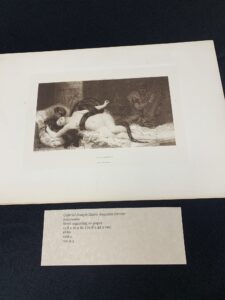The etching, “Salammbo,” depicts a naked woman, presumably dead, as an anaconda wraps itself around her body. There is also a man sitting behind the woman with a sitar or similar instrument in hand, presumably charming or controlling the snake. The woman is pale, with her hair billowing out behind her head. The setting is somewhere in the east, based on the clothing of the man and the background of the image. This etching portrays the “dangers” of the east, as a snake charmer possesses a snake which is wrapping itself around a defenseless, naked, exposed, and dead woman. We can assume this woman is supposed to be from the west because of her incredibly pale skin.
In The Woman in White, Count Fosco has a strange relationship with his animals. he has birds and mice which he calls his “children” and he either has them very well trained, or has some sort of mystic power over them. Count Fosco is from Italy, a foreigner in the context of this novel as it takes place in England. It is also worth mentioning that Count Fosco is arguably the main antagonist in this novel and the most threatening character to Laura, the stereotypical pale and fragile female character. Count Fosco is the mastermind behind the scheme to take Laura’s money as he manipulates everyone else. There is also a common rhetoric of Count Fosco being able to “tame anything” reinforcing the idea of him having control of people, but also animals in this story (Collins 217).
There is a common theme between “Salammbo” and the character of Count Fosco as an obsession with “the other” in relation to animals. In both cases, the foreigners have power or control over animals in a mystic or mysterious way. The English obsession with “the other” as a threat with mystic abilities was a common trope in art and literature. The snake charmer and Count Fosco’s similar ability to “tame” animals reinforces the idea of foreigners having power over animals, bringing in themes of “the exotic” as well.

I think that this is an excellent analysis. I had similar thoughts when I saw the picture. I was also unsure whether the woman in the picture was dead or just in ecstasy. I think that women and snakes are often put together to portray sensuality because of the slow and smooth movements of the snake. I am also wondering whether the snake could be viewed as a phallic symbol?
This could then be traced back to “the exotic”, as you said, that is seen as overly sexual and “uncivilized” in that regard, in opposition to the prude English Victorian.
This is a really thrilling analysis of the etching and The Woman in White, and so accurate. To think of Count Fosco as a snake-charmer or in the more accurate sense, an animal- and young woman-charmer, feels so radical, yet this is exactly what he is. In the way that you mention “Salammbo” portrays the dangers of the east, Count Fosco portrays the dangers of foreignness in The Woman in White. He hints at what could happen if a foreigner is allowed to take things too far; if he is ever given full power, he will corrupt and possess until they are all dead just like the woman in the etching.